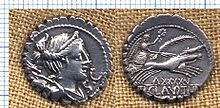Serratus (coin)
The Serratus , actually denarius serratus , is a form of the late Republican Roman denarius coinage . Its name comes from the serrated edge (lat. Serratus "sawn", "jagged"), which was attached before the minting - probably to show that the coin was made of solid silver and did not have an inferior core. Such a rim also offered protection against clipping of the coins . The first Serrati were made around 118 BC. Minted.
According to Tacitus ( Germania , Chapter 5), such serrati were particularly popular with the Germanic peoples.
The edge design with a corrugated edge , a pattern or a marginal writing became common again only in the 16th century . Today's 10, 20 and 50 cents as well as 1 and 2 euro coins with a fluted edge are the successors of Serratus.
See also
literature
- Arthur Suhle: Cultural history of the coins. Battenberg, Munich undated
- Rainer Albert: The coins of the Roman Republic. Battenberg / Gietl Verlag, Regenstauf 2003
Individual proof
- ↑ Albert, p. 131 ff., No. 1046 ff.
